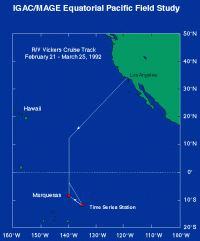MAGE 1992
This was the first field project of the International Global Atmospheric Chemistry Program's Marine Aerosol and Gas Exchange project (IGAC-MAGE). The experiment was planned to coordinate with the Joint Global Ocean Flux Study (JGOFS) in order to complement their oceanographic program with trace gas and atmospheric chemistry measurements. The specific goals of the IGAC/MAGE 1992 equatorial field program were to:
- Calculate air-sea exchange of short-lived biogenic trace gases using shipboard measurements of the important seawater and atmospheric species, air-sea exchange models and micro-budget flux estimates.
- Measure deposition of nutrients to the sea surface and the effects of these nutrients on ocean primary productivity.
- Compare the atmospheric chemistry and aerosol properties over productive (equatorial) and oligotrophic (12°S) waters.
- Calculate the cycling of trace gases in the upper water column using measurements of the key species as a function of depth and microbiological rate studies.
Both the R/V Vickers and R/V Wecoma conducted IGAC/MAGE experiments. Measurements aboard Vickers were aimed primarily at goals 1, 3, and 4. Measurements aboard Wecoma addressed goal 2.
The PMEL-JISAO Atmospheric Chemistry Group led the R/V Vickers cruise. The ship departed Los Angeles, California on 21 February, conducted a 6 day time series station at 12S, 135W, stopped in the Marquesas on 11 March and returned to Los Angeles on 25 March 1992.



